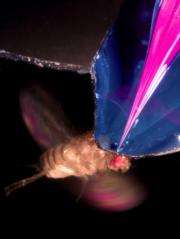First brain recordings from behaving fruit flies obtained (w/ Video)

Researchers at the California Institute of Technology have obtained the first recordings of brain-cell activity in an actively flying fruit fly.
The work—by Michael Dickinson, the Esther M. and Abe M. Zarem Professor of Bioengineering, with postdoctoral scholars Gaby Maimon and Andrew Straw—suggests that at least part of the brain of the fruit fly (Drosophila melanogaster) "is in a different and more sensitive state during flight than when the fly is quiescent," Dickinson says.
A paper describing the research appears February 14 in the advance online edition of Nature Neuroscience.
"Prior work on fruit flies has led to many important breakthroughs in biology. For example, the fact that genes reside on chromosomes and our understanding of how genes control development both emerged from experiments on fruit flies," Maimon says. "New research hopes to use these tiny insects to help determine how neurons give rise to complex behavior. This effort is helped by the fact that it is easy to manipulate the genes of fruit flies, but one problem remains: These insects are really, really tiny, which means it is very difficult to record from their brain during active behaviors such as flight."
"Researchers have recorded the neural-cell activity of fruit flies before, but only in restrained preparations—animals that had been stuck or glued down," Dickinson explains. "Gaby was able to develop a preparation where the animal is tethered"—its head clamped into place—"but free to flap its wings." By slicing off a patch of the hard cuticle covering the brain, "we were able to target our electrodes onto genetically marked neurons," he says.
A puff of air was used to spur the flies into flapping their wings, while electrodes measured the activity of the marked neurons and high-speed digital cameras simultaneously recorded the flies' behavior.
In particular, the researchers focused on those neurons in the fly's visual system that keep the animal flying stably during flight. "These cells basically help the fly detect when its body posture changes," Dickinson says. "The signals from these cells are thought to control tiny steering muscles that then change the pattern of wing motion and bring the animal back into equilibrium."
In their experiments, the researchers discovered that when the animals began to fly, the visual cells immediately ramped up their activity. "The neurons' responses to visual motion roughly double when the flies begin to fly, which suggests that the system is more sensitive during flight," Dickinson says. "The increase is very abrupt. It's not at all a subtle change, and so we suspect that there is a neurochemical quickly released during flight that sets the animal's brain in this different state."
Previous studies in locusts—which are far bigger and thus far easier to study—had suggested the existence of this effect. However, the genetics of locusts are not nearly as well understood as those of Drosophila, which has made it impossible to pinpoint the genetic basis for the phenomenon.
In Drosophila, Dickinson says, it now should be possible to "figure out specifically what causes the change in sensitivity. Is the system turned off when the fly is on the ground? What neurochemicals are involved? Now we can start to use the genetic tricks that are available in fruit flies to get a better idea of what is going on."
Maimon adds: "Our work on Drosophila is of general interest because sensory neurons in many species—including birds, rodents, and primates—change their response strength depending on the behavioral state of the animal, but why these changes in sensitivity take place is not entirely clear."
In addition, the researchers plan to use their tethered-flight system to record the activity of other types of cells, including olfactory and motor cells, to determine if these also behave differently during flight and when flies are at rest.
"The question is, 'Is the entire brain completely different in flight?'" Dickinson says. "We suspect that this phenomenon is not unique to the visual cells we have studied. Most cells care whether the animal is flying or not."
More information: "Active flight increases the gain of visual motion processing in Drosophila," Michael Dickinson et al., Nature Neuroscience.















